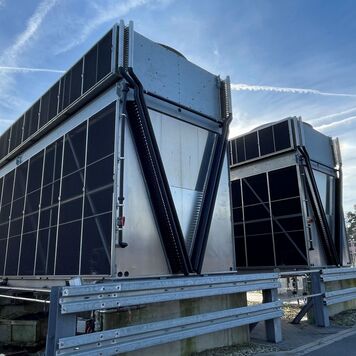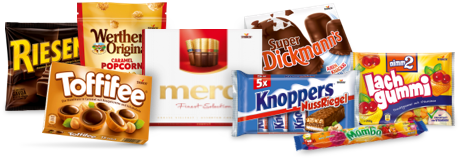Higher efficiency with hybrid recoolers
We use modern technologies for energy and cooling in its production processes: hybrid recoolers are a good example.

In confectionery production, cooling and refrigeration are essential for numerous manufacturing steps: ingredients are first dissolved, cooked and then tempered and cooled during processing into the finished product. The finished product must also be stored under optimal conditions. The cooling required for this is generated directly on site at Storck: ammonia refrigeration systems designed specifically for our usage profile often supply several production buildings at once. At the Halle site alone, cooling accounts for around 20% of annual water consumption and around 10% of electricity consumption. This is a significant proportion, which offers us opportunities to operate even more efficiently and thus conserve resources.
The operating principle of refrigeration systems
When generating cold using ammonia refrigeration systems (NH3 refrigeration systems), electrical energy is converted into thermal energy, i.e. cold. In the refrigeration systems we use, the thermal energy obtained is on average eight times higher than the electrical energy used.
The electrical energy is used to drive a refrigeration cycle. In this cycle, the refrigerant ammonia cools down significantly and can absorb heat from the environment at this stage. The refrigerant heats up while the environment is cooled. To maintain the cycle, the refrigerant must then be cooled down again. This happens in so-called recoolers, through which ambient air is conveyed by fans. This air heats up and simultaneously cools down the refrigerant.
In conventional dry recoolers, the heat is transferred directly to the ambient air (convective heat transfer). In wet cooling towers, the fins inside the recoolers are sprayed with water, which absorbs heat as it evaporates. In this case, the heat is not only transferred by convection, but also absorbed by the water, which greatly increases the cooling capacity.
The advantages of hybrid recoolers
We have been using hybrid recoolers that combine the functions of dry and wet cooling since 2011. Hybrid cooling systems are particularly efficient: they can deliver significantly higher performance in a smaller space, are less dependent on the ambient temperature and are more efficient than dry cooling systems at high outside temperatures.
Hybrid cooling units cool dryly as long as the ambient air is cool enough. Only when temperatures rise in summer do the hybrid cooling units switch to wet operation. The water used to wet the cooler fins is collected. It remains in the cooling circuit for as long as possible and is reused several times until it becomes too salty and is drained away in compliance with all limit values and official requirements.
By using hybrid recoolers, we have significantly reduced water consumption compared to conventional wet cooling: by 86% at the Halle site alone. The energy savings are also impressive: in Halle, the power consumption of the hybrid recoolers in 2023 was 35% lower than that of conventional wet cooling towers.
Efficient technology is standard at Storck
We have now installed 18 highly efficient hybrid recoolers at our production sites, each of which can deliver up to 5 MW of cooling capacity, depending on its size and the requirements of the refrigeration system. Although they involve considerable additional costs compared to wet cooling towers, they are now standard in new projects.
More information about the efficient use of energy.
